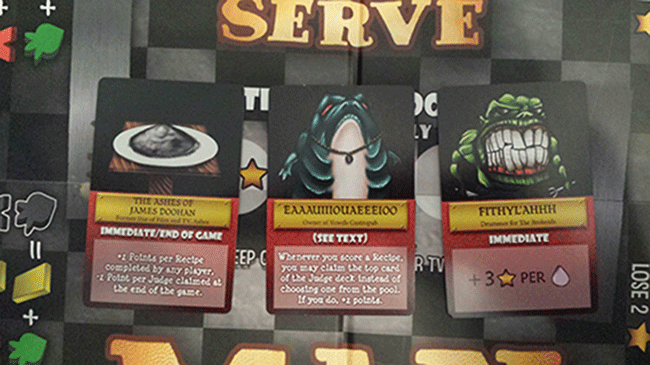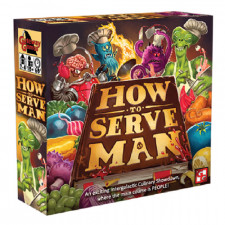How to Serve Man Review
on May 12, 2016
Finally, there’s a game about eating human entrails that the whole family can enjoy. How To Serve Man seeks to trim away excess fat from the worker placement genre, until it is left with something so pure and so straightforward that it can be enjoyed by just about anyone. It almost pulls it off too. Such a light design allows the players to spend their time shooting the breeze and enjoying each other’s company. It’s just that this is not really because of the game, which fails to engage with the players in a way that could have made the experience much better.
Still, How to Serve Man almost manages to be a winner based simply on how straightforward it is. It almost plays like “My First Worker Placement Game,†which isn’t actually a bad idea. This is perhaps the most unadorned game yet in that bloated genre, a simple exercise in putting a pawn on the board to take a small action. This could describe any number of games, but here it refers to an alien kitchen stadium, where the main ingredient is human meat. Those pawns are used to obtain ingredients (including people) and to combine ingredients into new ones. Each player is given a hand of recipes to fulfill by the end of the game, and more complex recipes earn more points when presented to judges. There’s a little bit of thematic flavor in the two different classes of chef that each player has, but mostly it’s a race to see who can get the highest score after someone has broken 50 points.

Even a new gamer will grasp all of the mechanics in a round or two, which is actually kind of a relief from the more complex worker placement titles out there. It shares some of the same advantages as Lords of Waterdeep, another game that used its basic structure to its advantage. The icky theme is also an advantage here, at least with the right group. There’s something lightly transgressive about throwing humans in a fryer to make a batch of Bicep and Buttocks with Martian Mustard.
That recipe title should tell you a lot about this game’s sense of humor, which leans hard on the “great big globs of greasy grimy gopher guts†method. Jokes will play differently for every group, but for me those jokes got old after about one game, after which it mostly became gross. But there are some other funny moments, particularly in the names of the judges, which are more surreal. I especially liked Yrrrrrrrrrr, the owner of YrrrrrrYrrrrrrrrrr, as well as Eaaauiiiouaeeeioo, the owner of Vowels Gastropub.
But those jokes eventually get old too, and that’s when this game’s weaknesses become obvious. One such weakness is how its ghoulish theme is only ever expressed in the recipe names. There’s nothing mechanical to move the game past the point of “place a guy to do a thingâ€. The only attempt is the event deck, a stack of cards that inject a measure of chaos into the proceedings. These cards are drawn whenever a player completes a recipe, and they throw the board into disarray in various ways, maybe by hurting the player in the lead or by making certain spaces more valuable.

However this also feels misguided. It tries to inject a little Cosmic Encounter into the game, but How to Serve Man madly misjudges why it worked so well in that classic design. Here it’s simply an obstacle the game throws at you, one that can mess up different players in unpredictable ways. It’s never based on what a player chooses to do, since they are drawn whenever a recipe is scored. The player never has any agency or ownership over what happens, making it feel like more of a circumstance than anything else. I’m not sure why these cards weren’t tweaked into something that players can play on opponents. For such a simple game, How to Serve Man studiously avoids any hint of player interaction beyond getting in each other’s way, and not even that happens a whole lot.
I’d be lying if I said I didn’t have fun playing How to Serve Man. It has the good sense to get out of the way and let people play, which is a lesson more designers should learn. But it doesn’t know when to stop removing elements, and in spite of the silly setting, the whole thing will feel bland to most gamers. In such a crowded genre, it has a hard time distinguishing itself.

 Customer Support
Customer Support  Subscribe
Subscribe 




 Account
Account  Wishlist
Wishlist 

